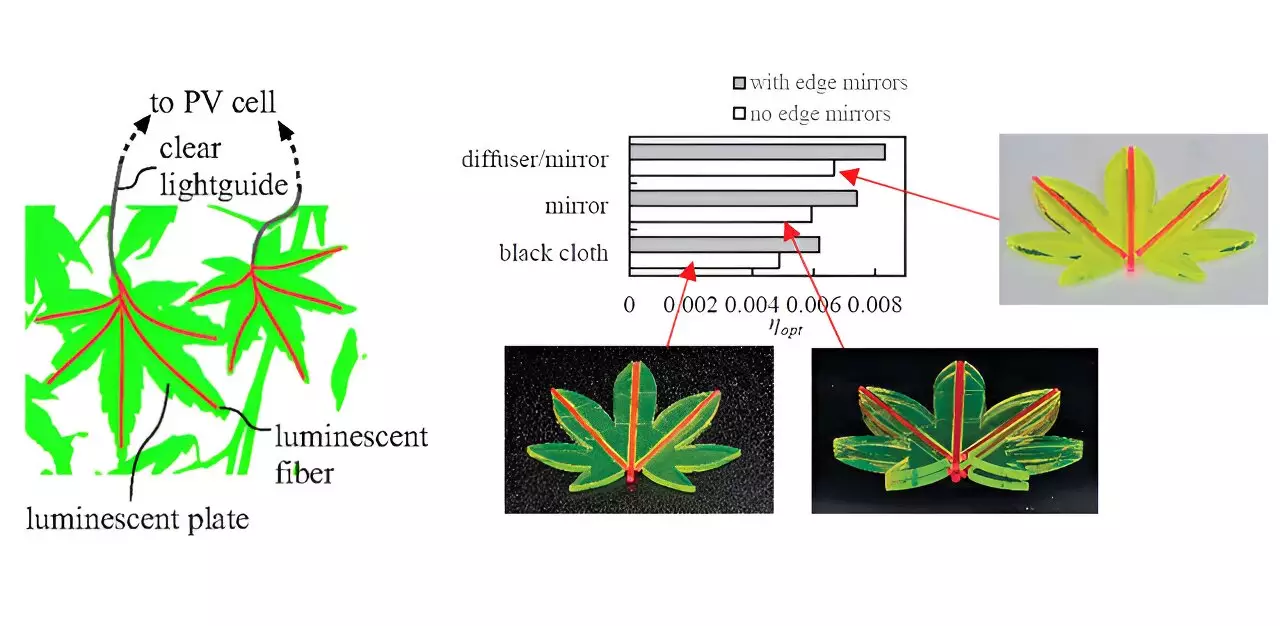The concept of luminescent solar concentrators (LSCs) has been around since the 1970s, with the aim of improving solar energy capture through the use of luminescent materials to concentrate sunlight onto photovoltaic (PV) cells. Traditional concentrators rely on mirrors and lenses, but LSCs have the advantage of being able to harvest diffuse light, making them ideal for applications such as building-integrated photovoltaics. However, scaling up LSCs to cover large areas has been a challenge due to issues like self-absorption of photoluminescent (PL) photons within the waveguide. To address this limitation, researchers at Ritsumeikan University in Japan have proposed an innovative “leaf LSC” model.
The leaf LSC design tackles the scalability problem by using smaller luminescent components that function like leaves on a tree. These interconnected components consist of luminescent plates placed around a central luminescent fiber, with the plates’ sides facing the fiber. This configuration allows incident photons to be converted into PL photons by the plates, which then travel through the fiber and are collected at its tip by a PV cell. To further improve efficiency, clear lightguides connect multiple fibers to a single PV cell, effectively increasing the incident area of the LSC and reducing photon losses due to self-absorption and scattering.
Modular Approach and Efficiency
The modular approach of the leaf LSC design offers several advantages. By reducing the lateral size of individual modules, researchers have observed significant improvements in photon collection efficiency. For example, reducing the side length of a square leaf LSC from 50mm to 10mm resulted in a marked increase in photon collection efficiency. Additionally, the modular design allows for easy replacement of damaged units and integration of advanced luminescent materials. Researchers have also incorporated techniques from traditional planar LSCs, such as edge mirrors and tandem structures, into the leaf LSC design to enhance optical efficiency.
The innovative approach taken by researchers in developing the leaf LSC model has drawn praise from experts in the field. According to JPE Editor-in-Chief Sean Shaheen, the findings represent a creative advancement in the concept of luminescent solar concentrators. The ability of these leaf-like structures to guide sunlight towards adjacent photovoltaic devices effectively demonstrates the potential for practical use. As the technology continues to evolve, optimized photon collection in LSCs holds promise for more flexible and scalable solar energy solutions. This could revolutionize the application of solar concentrators, making them more efficient and adaptable for a variety of uses, from large-scale installations to building-integrated systems. The advancements in luminescent solar concentrator technology could significantly enhance the performance of solar energy systems and contribute to more sustainable energy solutions overall.
The development of the leaf LSC model represents a significant breakthrough in solar energy technology. By overcoming scalability limitations and improving efficiency through innovative design and engineering techniques, researchers are paving the way for more effective and adaptable solar energy solutions. The potential implications of optimized photon collection in LSCs are vast, offering the promise of more sustainable and efficient energy systems for the future.


Leave a Reply